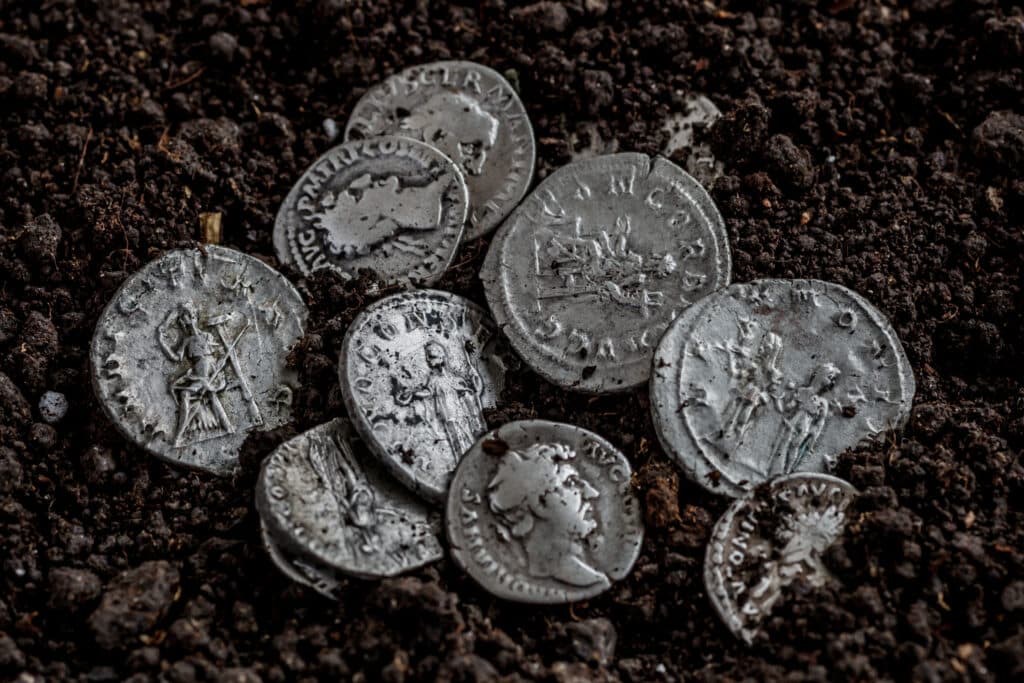Judas Iscariot’s 30 pieces of silver are so well known, so infamous in history, that it’s a euphemism for betrayal in Western culture. Have you ever wondered what those 30 pieces of silver were exactly – or how much they were worth? Scholars have debated these questions for years. Let’s go through some of their ideas.
The details of this story are found in the biblical book of Matthew, chapters 26 and 27. Before the Last Supper, Judas Iscariot, one of Jesus’s disciples, went to the chief priests and arranged to hand over Jesus to them, saying:
“What are you willing to give me if I deliver him over to you?” So they counted out for him thirty pieces of silver.
Later Judas, filled with remorse for his betrayal, threw the coins back at the priests in the Temple before he went and hanged himself. The priests decided that, as blood money, it could not be added to the temple treasury, so they bought the Potter’s Field.
Judas Iscariot’s 30 Pieces of Silver
The word the gospel writer Matthew used in Matthew 26:15 was argyria, meaning “silver coins.” This, obviously, is unspecific in terms of what kinds of coins they were. In 33 A.D. there were a number of possibilities for coins that might have been in circulation in Jerusalem, including:
- Tetradrachms of Tyre, or Tyrian shekels
- Tetradrachms or Staters of Antioch
- Ptolemaictetradrachms
- Roman denarii
Of these, Tyrian shekels had the highest silver content – 94% – so these were what the priests required as payment for the temple tax. This coin contained 14 grams of silver. Today’s spot price for silver is $.63 per gram. The silver in these 30 coins would be worth $264.60 today. The coins themselves, being ancient and historical, would of course be priceless, but at the time they were just regular silver coins used by regular people to buy and sell at the market.
That $264.60 is a value out of time, however. You can’t just say that Judas betrayed Jesus for 265 dollars. The above coins vary greatly in how much silver they contain, You would also have to know the going rate for a man’s labor in 33 A.D. and what the cost of living was in Jerusalem in order to determine how much money the chief priests paid for Jesus’s life.
What’s more revealing is the gospel writer Matthew’s intent. The phrase he used, “30 pieces of silver,” is a throwback to a reference in the book of Zechariah. In Zechariah 11 this phrase is used to mean the value of a slave and is based on Jewish Law. Exodus 21:32 states:
“If the bull gores a male or female slave, the owner must pay thirty shekels of silver to the master of the slave, and the bull is to be stoned to death.”
The prophet Zechariah asked the Israelites to pay him for the work he had done working among them, that’s what they gave him. It was meant to be an insult; they didn’t value his prophecy. Jehovah told Zechariah to throw this slave’s wage into the treasury (back in their faces).
So when Matthew says 30 pieces of silver and has Judas throw it back into the treasury, it’s an allusion to this story in Zechariah in which unfaithful Jews undervalued a prophet of the Lord with an insulting amount of money – what a slave is worth. Matthew is saying the priests were willing to pay almost nothing for Jesus. They were angry at Jesus for the scene he’d made at the temple overturning the moneylenders’ tables and railing against the corrupt priests profiting off the sacrifices people brought to the Jerusalem to make to God out of devotion and duty.
Thirty pieces of silver to the priests, to Matthew, to Zechariah, then, was the price of contempt.
It’s interesting that this phrase “30 pieces of silver” has had a negative meaning of contempt or betrayal for thousands of years, even though silver itself has been valued as a precious metal for the same amount of time or longer.
If you’d like to know more about any of the silver coins referenced above, make an appointment to talk to us today by calling Grand Rapids Coins at 616-884-5048. We would love to help you track down any of these coins for your collection. Old coins make history come alive!

